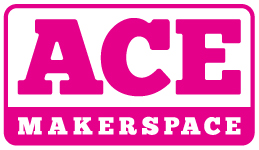Ace Best Practices
Ace strives to embed diversity, inclusion, and equity in all we do, including designing workshops, classes, and events. Org sponsored offerings use the following structure:
Access-based Education – Competency and certification classes, certification testing for the experienced users. This is required education that gates access to tools. These offerings are always as economically accessible as we can make them and are supported by additional fundraising to support scholarships.
Exposure-based Education – These are considered “taster” classes where users make something very simple and small in a supervised, guided way. These workshops would be to get folks thinking about the possibilities and create a sense of approachability. These bridge workshops also provide a pathway to mentorship that is facilitated by the organization.
Long-Form Project-Based Experiences – These are fancy workshops designed as part experience/part fundraisers. These are pipeline classes for future philanthropy and board members. Examples of options would be a 4 part course to build a small piece of furniture or art. Certification would not be part of the courses though there would be some competency crossover.
Develop some content
Things to consider when you are developing content:
Is this a class or an open lab?
If this is a class: Will there be hands-on portion of the class? Will students need to bring a laptop? If so, what software will they need? What physical materials will you need as the instructor? What physical materials will students need? Does this class require special clothes? Should folks bring a snack or lunch? Will you need to print out handouts?
If this is an open lab: what equipment will folks have access to? What software or knowledge base will they have access to? What are other particpants likely to be working on? Will there be food or drink or should folks bring their own? What supplies will folks have access to… to keep or to practice on. Why is your lab neat?
Figure out your logistics
- How long is the class? (Start / Stop times. Don’t forget to leave enough time for participants to help you clean up)
- What date is the class? (two weeks lead time from announcement to event is best)
- What is the RSVP fee? (minimum is usually $7)
- How many people can attend your class comfortably?
Craft your content
- Create a description of what people will learn or experience at your event. It doesn’t have to be long and can even be a bulleted list
- Find/take some pictures that are relevant to what you will teach… at least one hero image is perfect
- Consult with other instructors and officers to confirm the awesome premise and that it meets Ace’s diversity, equity and inclusion best practicies
Announce your event
- If you have host permissions to the Ace Monster Toys Meetup group and post your event. (you will know based on the options in the event.. like can you charge fees)
- If you are not an Eventbrite group host, send all the logistic and content information to @Crafty Rachel and she will post the event with you as the host in Eventbrite. More than one person can host an event 😉
- Next Talk about your event on your social media linking back to the Eventbrite
- Add a link to your event to any relevant web pages on the website
What not to do
- Announce an event without an RSVP fee
- Announce an event without enough time for folks to go
= Holding your Event =
The following are good ideas, not requirements… okay some are requirements.
- Plan enough time to set up your room or space
- Put out the sandwich board before your event
- Plan enough time to clean up after your event
- Bring the sandwich board in after your event
- Put out a donation can for your event
- Hand out material about how to be a member to interested parties
